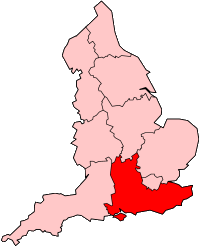Fawley Power Station
| Fawley Power Station | |
|---|---|
RWE npower (1990–2013) | |
| Operator(s) | Central Electricity Generating Board (1971–1990) RWE npower (1990–2013) |
| Thermal power station | |
| Primary fuel | Oil-fired |
| Secondary fuel | Fuel oil for auxiliary gas turbines |
| Chimneys | 1 (198 m) |
| Cooling towers | None |
| Cooling source | Sea water |
| Power generation | |
| Units operational | 4 × 500 MW |
Annual net output | 5271.594 GWh (Year 1980/81) |
grid reference SU473021 | |
Fawley Power Station was an oil-fired power station located on the western side of Southampton Water, between the villages of Fawley and Calshot in Hampshire, England. Its 198-metre (650 ft) chimney was a prominent (and navigationally useful) landmark, but it was not, as is sometimes claimed, the highest point in Hampshire (which is Pilot Hill).
Overview
The station, which in its final years was owned and operated by Npower, was oil-fired, powered by heavy fuel oil. Pipelines connected the station to the nearby Fawley oil refinery. There were two 10-inch (25 cm) diameter, 3.2-kilometre (2.0 mi) long, pipelines which discharged into storage tanks with a capacity of 24,000 tonnes.[3] Due to oil being more expensive than other fuels such as coal and natural gas, Fawley did not operate continuously, but came on line at times of high demand.
It was also connected to the National Grid with circuits going to Nursling and a tunnel under Southampton Water to Chilling then to Lovedean with a local substation at Botley Wood.
A dock was included in the construction, to allow for the delivery of oil by sea; however, after one ship delivery (essentially a trial) this facility remained disused.
History
Fawley was built by
(MW) power station, with four 500 MW generating units, each consisting of a boiler supplying steam to a turbine that powers an associated generator.The boilers were capable of delivering 1,788.0 kg/s of steam at 158.6 bar and 538 °C.[7] The cooling pumps were Britain's largest with a flow of 210,000 GPM. One was driven by an experimental super-conducting electric motor.
In 1978/79 Fawley was presented with the Hinton Cup, the

The operating data for the main plant is shown in the table:[9]
| Year | Net capability, MW | Electricity supplied, GWh | Load as percent of capability, % | Thermal efficiency, % |
|---|---|---|---|---|
| 1972 | 2,000 | 7,059.640 | 48.5 | 34.38 |
| 1979 | 1,932 | 10,047.995 | 59.4 | 35.53 |
| 1981 | 1,932 | 5,271.594 | 31.1 | 34.24 |
| 1982 | 1,932 | 4,723.965 | 27.9 | 36.87 |
| 1984 | 1,932 | 2,007.425 | 11.8 | 34.27 |
| 1985 | 1,932 | 12,980.721 | 76.7 | 37.87 |
| 1986 | 1,932 | 2,110.406 | 12.5 | 35.18 |
| 1987 | 1,932 | 4,234.020 | 25.0 | 36.223 |
The electricity output, in GWh, is shown graphically:
Graphs are unavailable due to technical issues. There is more info on
1984/5 Miners' Strike, and the shortage of coal for coal-fired power stations. There were also 4 × 17.5 MW auxiliary gas turbine generators on the Fawley site giving a total output of 70 MW, these machines had been commissioned in September 1969.[7][10]
Two units were mothballed in 1995,[11] leaving the station with a capacity of only 1,000 MW. Proposed Fawley B stationCEGB plans for a coal-fired Fawley B station were not pursued following privatisation of the industry in the late 1980s. ClosureOn 18 September 2012, RWE npower announced they would be shutting down Fawley power station by the end of March 2013, due to the EU Large Combustion Plant Directive.[12] The power station was duly shut on 31 March 2013 after more than 40 years in operation.[13][2] Impact on wildlifeWhen the plant was operating, the screens on the plant's cooling water lines were found to kill as many as 50,000 fish a week.[14] By the 1980s, intermittent plant operation meant that the annual kill total was around 200,000.[14] While this may have resulted in reduced numbers of some species such as bass, others such as sand smelt seemed unaffected.[14] Use in media The unique round structure housing the control room for the station was used to represent the "World Control Center" building depicted in the 1975 film Rollerball.[15] Some scenes for the 2015 film Mission: Impossible – Rogue Nation were filmed on location at Fawley power station.[16] The second series of British medical comedy Green Wing featured a scene that was shot in the control room. The Red Dwarf series 11 episode "Give and Take" had a scene that was filmed inside the control room.[17] The 2017 Channel 4 programme Spies filmed at the station and inside the control room. The final episode Harvest of series 4 of Endeavour used the power station and control room. The exterior of the power station was used as a filming location for the Star Wars film Solo: A Star Wars Story.[18] The location was used as the extraction point for the 2018 series of Celebrity Hunted. The successful fugitives escaped by speedboat, exiting into Southampton Water. Demolition and regenerationIn 2017 it was announced that the power station site would be turned into a " New Forest District Council approved the scheme in July 2020.[22]
In June 2019, it was announced that the station would be demolished in several stages.[23] The first stage took place on 3 October 2019, with a controlled explosion of the turbine hall.[24][25] The southern section of the boiler house was demolished on 19 November 2020.[26] Demolition continued on 29 July 2021 with a further controlled explosion of the stations auxiliary buildings.[27] The chimney and remaining southern end of the turbine hall were demolished simultaneously at 7am on 31 October 2021.[28] In February 2023, demolition work began on the control building.[29] See alsoReferences
Wikimedia Commons has media related to Fawley Power Station. |

